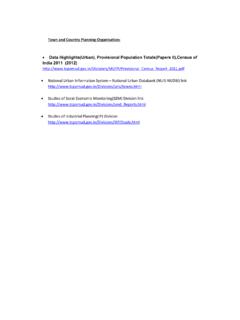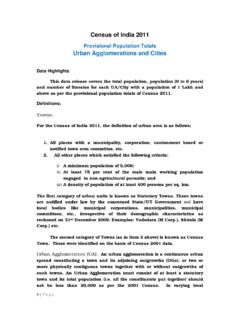Transcription of Impact of Urbanisation: A Comparative Overview of …
1 International Journal on Emerging Technologies 8(1): 375-380(2017) ISSN No. (Print) : 0975-8364 ISSN No. (Online) : 2249-3255 Impact of urbanisation : A Comparative Overview of Four Mega Cities in India Pooja Sharma* and Sumit Sharma** *Assistant Professor, Daulat Ram College, University of Delhi **Department of Environment Studies, University of Delhi (Corresponding author: Pooja Sharma) (Received 28 December, 2016 accepted 18 January, 2017) (Published by Research Trend, Website: ) ABSTRACT.
2 With the emerging growth in population and increasing urbanisation characterised by growing number of vehicles in mega cities has led to a detrimental Impact on environment and climate across all mega cities in India. This excessive urbanisation has overloaded the limited scarce resources and deteriorated the environmental quality, affecting natural resources and environment. This paper overviews the trend of urbanisation captured by increasing population and variations in temperature from period 1951 to 2001 for the four mega cities in India The paper also examines the trends observed in various indicators of climate change like temperature, rainfall four mega cities of India namely Delhi, Kolkata , Chennai and Mumbai for the period 2001 to 2009.
3 The paper clearly exhibits the Impact on climate change by observing the trends in temperature and precipitation. This Impact is captured by computing the correlations between the urbanisation and climate change variables measured as temperature signifying that population holds a very strong significant correlation with temperature variation in all the three mega cities ruling out Delhi. Further the correlation between population , vehicles, temperature humidity and rainfall is computed for Delhi and it is concluded that the rise in population and urbanisation captured by number of vehicles have a positive and high correlation on percentage of humidity as an indicator of climate.
4 Key words: urbanisation , Climate, Correlation. I. INTRODUCTION The notion of growth and development is associated with movement of population from rural areas to urban areas in search of better life and living standards. But unfortunately this influx of population further puts pressure on limited resources of urban cities. India has observed a tremendous economic growth coupled with population growth and thereby leading to excessive urbanisation .
5 Economic growth on one hand has increased agricultural and industrial growth and at the same time on the other hand tremendous increase in population has put an excessive pressure on limited resources of urban areas. In India metropolitan cities have undergone immense urbanisation consequently deteriorating environmental quality of these cities. According to 2011 census of Indian population lives in urban setup and three of the world s ten most populous cities are in our country namely Mumbai, Delhi and Kolkata.
6 The recent trend of increased urban growth has outstripped the limited capacity of these cities to provide basic services as a result we are facing more serious challenges like environmental degradation which include increasing air and water pollution, decreasing forest cover, wetlands and croplands, decreasing biodiversity, increased brown field areas and inadequate sewage and waste disposal. Mohan, Manju (2011 ) evaluated Delhi on the basis of land use and concluded that Delhi has expanded by 17% on the expense of agricultural land, waste land and water bodies between 1997 to 2008.
7 During the same period the forest cover of Delhi has increased by and water bodies have decreased by Rao, AK Jaswal, MS Kumar, Mausam, (2004) carried out a linear trend analysis for different meteorological parameters in 15 selected cities shows that population density, tall buildings, vehicular and industrial pollution are the main players which is controlling the urban climate. General trend in these cities is of decreasing sunshine, cloud cover and wind speed while there is an increase in temperature, rainfall and humidity.
8 Kundu (2011) pointed out that the process of urbanisation in India is more oriented towards larger cities. et Sharma and Sharma 376 The reason quoted was that the larger cities are more efficient in generating growth and attracting investments whereas smaller towns located away from the emerging global centres of growth have not attracted much private investment and hence has reached economic stagnation.
9 Bhagat (2011) figured out that the declining trend of urbanisation in 90 s is reversed in the last decade and the level of urbanisation increased faster during 2001-11(from 286m in 2001 to 377m in 2011) period mainly because of rural to urban migration and large base of urban population which has implications for providing urban infrastructure and amenities. Dhode, Dhorde and Gadgil (2009) examined the effect of urbanisation on minimum and maximum temperature general trend found is increase in average temperature with different rates in different season except Mumbai where minimum temperature during monsoon and winter showed a significant decrease.
10 Bherwani, Hemant and Kumar used the time series analysis on temperature profile of Mumbai city was carried out and triple exponential smoothed curve was fitted in order to demonstrate the trend of temperature profile of the city and it was further forecasted using the time series equation and general methodology of curve fitting. This paper specifically focuses on the four of the India s mega cities namely Delhi, Kolkata, Chennai, and Mumbai which have distinctly gone through tremendous urbanisation .











